#lennon-McCartney
Explore tagged Tumblr posts
Text
Sometimes, I think about this interview a little too much...
(from McCartney's German interview 1984)
Interviewer: "But your relationship with John, I mean, in every way, as a band I mean, you were very, very close. I mean, that must have been very painful in that respect. Not only the Beatles breaking up. But, I mean, that particular relationship breaking up."
McCartney: "Mm. It was, yeah. Um, in our songwriting, I had signs that the group was gonna break up, because… I mean, I think really what it was, really all that happened was that John fell in love. With Yoko. And so, with such a powerful alliance like that,it was difficult for him to still be seeing me. It was as if I was another girlfriend, almost. Our relationship, strong relationship. And if he was to start a new relationship,he had to put this other one away. And I understood that. I mean, I couldn’t stand in the way of someone who’d fallen in love.You can’t say, you know, “Who’s this?” You can’t really do that.If I was a girl, maybe I could go out [unintelligible] in this case, you know, it's just that, uh, you know, I mean, I didn’t say anything, I could see that was the way it was going to go, and that Yoko would be very sort of powerful for him, you know? We all had to get out the way. I don’t blame her. You know, you can’t blame her for being the object of his love."
#the beatles#paul mccartney#paul mccartney interview#john lennon#lennon-mccartney#beatles interview#dare i say mclennon?#lol lmao
388 notes
·
View notes
Text



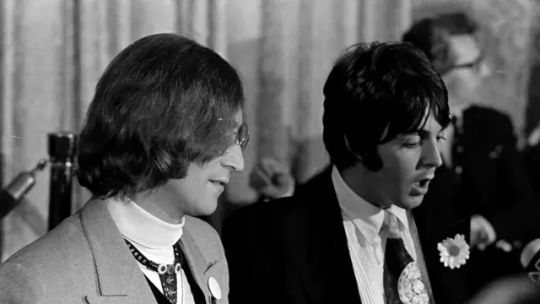






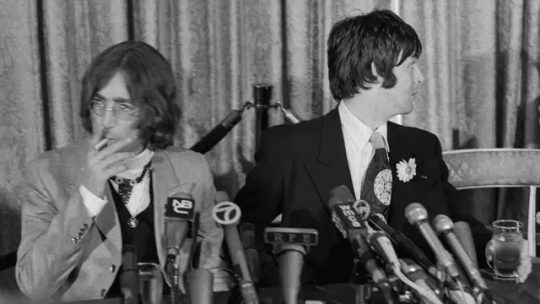

"STOP THE PRESSES! NEWS JUST IN!" -- APPLE CORPS IS BORN... AND THE FINAL END IS SOWN.
PIC(S) INFO: Part 1 of 2 -- Mega spotlight on BEATLES musicians John Lennon and Paul McCartney holding a press conference at the Americana Hotel in New York City, USA, on May 14, 1968, to announce the formation of Apple Corps. 📸: Sal Traina, Vincent Vigil, various, etc...
Sources: www.reddit.com/r/beatles/comments/hg7xox, Pinterest, Getty Images, Morrison Hotel Gallery, various, etc...
#John Lennon#Paul McCartney#THE BEATLES#Photography#60s rock/pop#New York City#New York#NYC#1960s#Sixties#60s#Bass player#Guitarist#60s Style#60s fashion#1968#THE BEATLES 1968#Americana Hotel#American Style#Macca#Lennon McCartney#B&W photography#Bassist#Vintage fashion#60s rock#Lennon-McCartney#Vintage Style#British rock#BEATLES#BEATLES 1968
97 notes
·
View notes
Text


I don't know if it's just me, but I feel so much love from these pictures of John taken by Paul.
It's like every moment of John's is beautiful and important to Paul, which makes him want to record it. John in the mirror in the morning was beautiful and important to Paul at the time, it's something simple but that keeps so much love.
and let's not forget the fact that most of these photos are tagged as paul's favorites.
142 notes
·
View notes
Text

The famous Abbey Road album cover photo taken on 8 August 1969
#Abbey Road#The Beatles#London#zebra crossing#iconic#streetscape#urban art#album cover#famous photos#UK#John Paul George & Ringo#Lennon-McCartney#beatlemania
16 notes
·
View notes
Text
I'd be fascinated to know what songs Paul wished he had John to work on with
#filed under: questions that are interesting that probably no one should ask him#fiona.docx#lennon-mccartney
7 notes
·
View notes
Text
youtube
10 notes
·
View notes
Text


"I was very lucky I made it up with John before he died. That was really lucky, important, for me." ㅡ Paul McCartney for Pauline Sutcliffe.
#john lennon#paul mccartney#the beatles#60s#lennon-mccartney#the beatles shadow#pauline sutcliffe#my:gifs#my:read
15 notes
·
View notes
Text
Since it's the first, I'll just post some of my favourite pics of them. Also, nice time to find out I like black and white so much apparently



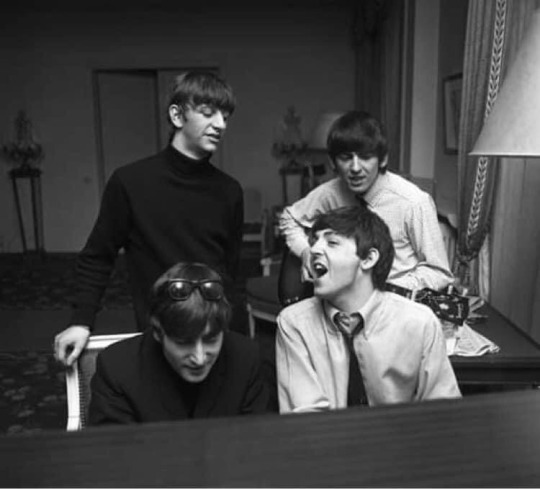

Also this one. God bless, it's so stupid. I love it so much

#lennon-mccartney#john and paul#beatles#the grainiest and most haunting pictures#the hard day's night one is so beautiful I can't believe it's from the movie#the person I actually picked as my partner
6 notes
·
View notes
Text
Un disco dei Beatles sotto l’albero. Library Concert: un omaggio a John Lennon e ai Beatles a Serravalle Scrivia
Serravalle Scrivia si prepara a ospitare un evento unico e carico di emozione: il Library Concert dedicato a John Lennon, organizzato dal Comune di Serravalle Scrivia negli spazi accoglienti della Biblioteca Comunale “Roberto Allegri”.
Serravalle Scrivia si prepara a ospitare un evento unico e carico di emozione: il Library Concert dedicato a John Lennon, organizzato dal Comune di Serravalle Scrivia negli spazi accoglienti della Biblioteca Comunale “Roberto Allegri”. L’appuntamento è fissato per giovedì 12 dicembre alle ore 17, un’occasione imperdibile per gli amanti della musica e per tutti coloro che desiderano ricordare uno…
#Alessandria today#anniversario John Lennon#Arte e Musica#Beatles#Beatles storia#Biblioteca Comunale Roberto Allegri#Biblioteca Serravalle#concerti Beatles#concerti biblioteca#cultura e musica#Cultura Musicale#Eventi Alessandria#eventi dicembre 2024#Eventi Musicali#eventi natalizi#giornalismo musicale#Google News#italianewsmedia.com#John Lennon#Lennon canzoni#Lennon vita e musica#Lennon-McCartney#Library Concert#musica anni ‘60#musica classica pop#Musica dal vivo#musica iconica#musica intimistica#omaggio a Lennon#pacifismo
0 notes
Text
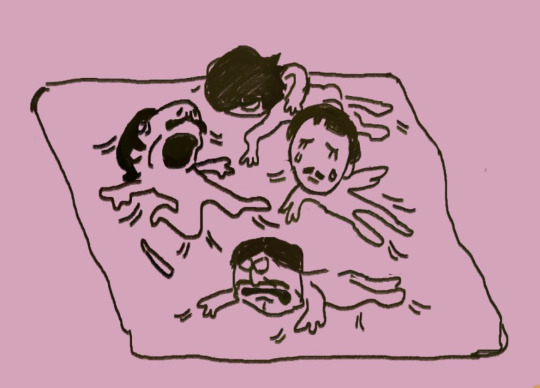
All of the Beatles dying in a glue trap
36K notes
·
View notes
Text
hey girl i mean jude
#the beatles#paul mccartney#john lennon#george harrison#ringo starr#the neighbors take a certain pride in you
11K notes
·
View notes
Text








IN BETWEEN "THE WHITE ALBUM" SESSIONS -- DOING THE PRESS ROUNDS IN THE BIG APPLE.
PIC(S) INFO: Part 2 of 2 -- Mega spotlight on John Lennon and Paul McCartney of English rock band THE BEATLES, launching Apple Corps to the world via a press conference on a Tuesday afternoon at the Americana Hotel in New York City, on May 14, 1968.
PRESS: "Are THE BEATLES still meditating?"
JOHN: "Now and then."
Sources: https://x.com/BooksBeatles/status/1636325653220933639, Pinterest, Reddit, various, etc...
#THE BEATLES#THE BEATLES 1968#BEATLES#BEATLES 1968#1968#60s rock#Apple Corps#Sixties#1960s#60s#Bass player#Bass guitar#John Lennon#Paul McCartney#Photography#60s rock/pop#British rock#New York City#New York#NYC#60s fashion#American Style#Lennon McCartney#Bassist#Vintage fashion#Americana Hotel#B&W photography#Guitarist#Lennon-McCartney#60s Style
3 notes
·
View notes
Text
All you need is $300
Where we go and buy the all new Beatles re-mastered stuff. Well forgive me! I like a lot of Beatles songs, like not love. I love their simplicity and the pictures they paint in my head. Written, often, by men who’d had a quick pull on the wacky baccy it seems. Nobody likes the drummer though. The man we knows as Simon “the spice girls will never amount to much” Cowell recons that they’d fail a…
View On WordPress
0 notes
Text
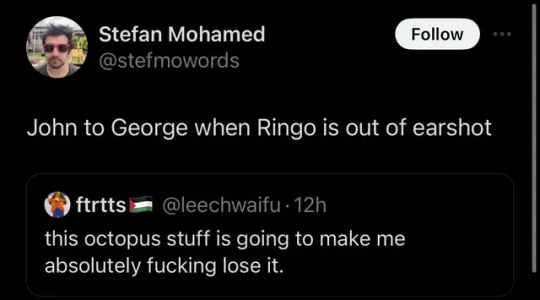
#this is doing numbers#follow me for more beatles bangers guys#god john was on something back then#john can't possibly hate octopus's garden more than maxwell's silver hammer#poor ringo#what was paul's take on that octopus song#i love it though#loved that scene where george was helping ringo with that song#made me believe in starrison#peace and love everyone#the beatles#john lennon#paul mccartney#george harrison#ringo starr#beatles#memes
14K notes
·
View notes
Text
while my guitar cries so hard it throws up
#the beatles#george harrison#john lennon#paul mccartney#ringo starr#rock#rock music#music#shut up meep
3K notes
·
View notes
Note
do you think john thought paul was special? I get sad when I read about what he said about paul in the 70s, especially because paul has always thought john was special. but john was calling him engelbert and saying paul died creatively and was his last gasp. so did he think paul was untalented?
I want to preface this with: I do not have access to John Lennon's living thoughts, I just can read the same quotes everyone else can. So bear in mind that this is just my take, please.
If anything, I don't think John's problems with Paul were a lack of talent – he many times pointed out Paul's talent as the thing which convinced him to let Paul join his band (as opposed to say, Paul's organiztional skills or what have you) – but I think he sometimes found himself frustrated with what he felt was Paul's unfulfilled musical potential. I think John did think Paul was special but felt some of that specialness was "wasted", because he didn't find all of Paul's creations as interesting or "deep" as it could be.
I also think there's a non-zero chance that John let his personal issues with Paul cloud his judgement of Paul's music. But all of that is very complicated and seems to have changed from day-to-day.
9 notes
·
View notes